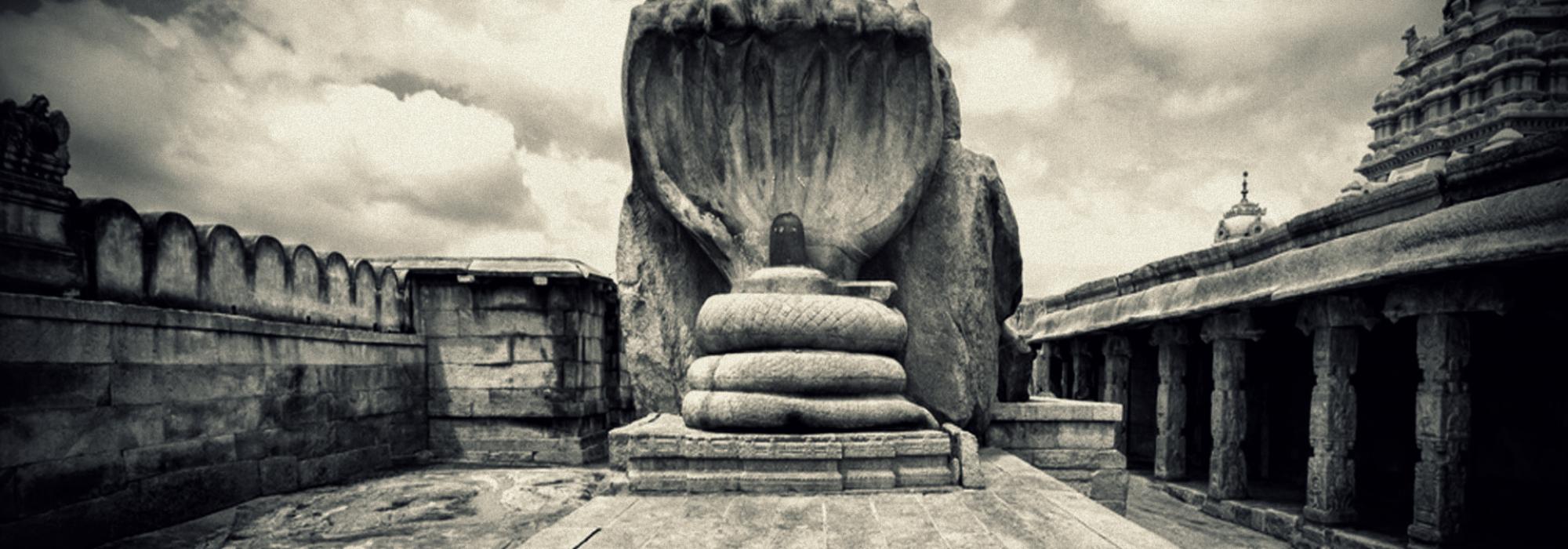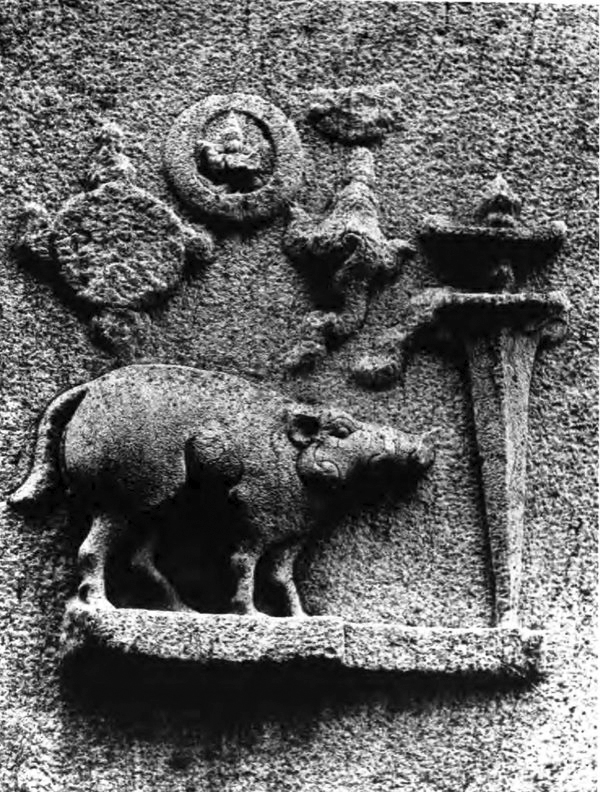We will never tire of repeating that quote of Vidyaranya from his Panchadashi that amply illustrates how he managed affairs of state as well as those of the Spirit:
ज्ञानिना चरितुं शक्यं सम्यग्राज्यादिलौकिकम्
It is indeed possible for the enlightened one to navigate politics and worldly affairs well
All of the following must be seen in this light. As a sanyasi is forbidden (at least according to dharmashastras) from engaging in acts that show an interest in the mundane and knowing how Vidyaranya adhered to the spirit and letter of dharma, it will be safe to surmise that all of the activities described in this piece were done in his householder phase.
We find several occasions in history during which kingdoms were established with the inspiration and blessings of saintly personages. For example, Sudatta muni guided the Hoysala dynasty and Simhanandi muni guided the Ganga dynasty. Often the inspiration seemed to be a one-time event that did not extend to the different spheres of politics, spirituality, and culture. This unique greatness belonged to Madhava and Sayana as they were not just visionary scholars and but also ministers well-versed in statecraft and the military arts. As reformers, they were sympathetic to the needs of different sections of society and finally they were philosophers with all-encompassing vision.
For over fifty years, the Sangama dynasty and through them, the Vijayanagara empire was guided in no small extent by these two brothers. It is fitting that they be compared to the finest nation builders such as Krishna and Kautilya and not just to poet-scholars or other spiritual leaders. The fact that several historians fail to realize the extent of their contributions is lamentable.
The establishment of the Vijayanagara empire was a watershed event in the history of India. The standard narrative is that Harihara and Bukka, chieftains of the Northern and Western regions of the Hoysala kingdom peacefully took over the reins of the kingdom from the aging Ballala III without war or bloodshed. By this time, the Sangama brothers had gained prominence in the Tulunadu area and Malenadu and coastal regions of Karnataka. Edicts call out the date of the establishment of the empire as the seventh day of Vaishakha (with the Makha star in conjunction) in the year Dhatu, which translates to 17 May 1336 in the Gregorian calendar. This date, though traditionally believed to be the date of the foundation of the capital of Vijayanagara, is likely to mark the day when the dream of a kingdom that establishes dharma arose in the minds of the Sangama brothers.
It was unfortunate that (around 1342) the aged Ballala III, after having successfully won the Battle of Tirucchirapalli, was killed by his Muslim enemies through deceit and his body was subsequently humiliated. The actual date of the establishment of the kingdom is closer to 1345 or 1346 CE with the kingdoms comprising the erstwhile Hoysala kingdom gradually going over to the Sangama side in the intervening period.
If the establishment of the kingdom happened in a bloodless way, it would have been the result of strategic thinking, negotiations with local chieftains and abundant use of statecraft in the form of sama, dana, and bheda, without taking recourse to danda. Will it not be more prudent, then, to surmise that all of this happened due to the keen intellect of Madhava rather than the blade of Harihara? The pen and the mind move easily where the sword cannot even enter! Several historians now attest to the fact that Madhava as the kulaguru (teacher and guide to the clan) and minister to the Sangama brothers formed the Vijayanagara kingdom primarily following the path of negotiation.
Vira-kekkayi-tai, the wife of Ballala III; his son-in-law Billappa-danda-nayaka; and Bhima-nayaka, the right hand of Ballala III supported Harihara and Bukka of their own will. So did Mallinatha (the ruler of Chitradurga), Bhairideva, Macchideva, and Allalaji (the rulers of Yelahanka), Baichappa (the commander of the Taulavas), Angirasa-Madhava, and a host of contemporary leaders. The fact that Madhava-Vidyaranya made all of them transcend their clan and religious barriers to support the larger cause of the Vijayanagara empire is ample testimony to his vision and skill of negotiation.
Founding a kingdom is one thing, but protecting it from internal troubles and external invasions is a different matter altogether. The first issue was pressing the people, wallowing in poverty due to pillage and plunder of previous invasions, for new taxes to build the new kingdom. In this crisis, Madhava used the finances of mathas, temples, and other institutions of faith in an innovative fashion without hurting the sentiments of those involved, thereby demonstrating that helping the nation was the duty of one and all.
D V Gundappa reasons that this probably was the background for the legend of the rain of gold. (According to legend, Madhavacharya performed tapas to invoke Devi Bhuvaneshvari, who then proceeded to shower gold on Vijayanagara. This was said to be the reason for the new found richness of the Vijayanagara empire). The use of temple money for building or repairing tanks or other public works has been well-documented in several edicts.
By distributing responsibilities among the Sangama brothers and extended family members, Madhava ensured that familial harmony was retained. While Harihara ruled over Vijayanagara, his second brother Bukka was nominated to rule over the second capital Dvarasamudra, under the able guidance of Madhava as Prime Minister. Kampana, Harihara’s first brother was nominated to rule over Udayagiri. Madhava sent his Sayana as guru, minister, and general to guide Kampana. In a few years, Kampana and Sayana took over Nellore and Kadapa. Following the untimely demise of Kampana, Sayana protected the new king, Kampana’s young son, Sangama II as a regent. When a local king, Champaraya threatened to disturb the peace of Udayagiri, Sayana himself went to battle, captured Champaraya and his capital, Garudanagara and made him a vassal of the Vijayanagara empire. Angirasa-Madhava, also a warrior-minister, was made a minister of Marappa, another brother of Harihara who ruled over the western provinces. Under Angirasa-Madhava's guidance, Marappa was able to extend the boundary of the Vijayanagara kingdom to Goa.
After stabilizing the local kingdom, Madhava then looked at the other parts of South India that were still under Islamic rule. Remembering the heinous treatment meted out to Ballala III and his people as the result of being complacent, Madhava decided to uproot all vestiges of alien rule in South India. It was with this intent that the Pandya, Tundira, and the Chola kingdoms were unyoked from Islamic rule. Important centers of faith such as Madurai, Sriragam, and Kanchipuram were liberated by generals of the Vijayanagara empire.
Madhava ensured that there would be no internal strife after the passing away of Harihara by ensuring that the succession of Bukkaraya to the throne happened smoothly. At this time, Madhava toured the northern regions of India and witnessed the cultural and political situation first-hand. It was probably then that he brought the distressed groups of artisans, merchants, and scholars to Vijayanagar. This in turn formed the foundation of the renaissance of santana dharma.
An interesting digression here has to be made of the emblem of the Vijayanagara empire which depicted the uplift of sanatana dharma. It is likely that this might have received ample guidance from Madhava.
The emblem of the sun, the moon, and a sword along with वराह, the great boar is significant. The boar (varaha) emblem was used by the Chalukyas earlier. Varaha – an avatara of Vishnu – is famous for destroying Hiranyaksha (one who had eyes only for gold – depicting one who hankered solely after sense pleasure) and uplifting Mother Earth, personified as भूदेवी on the tip of his tusks from the waters of the primordial deluge. This emblem personifies the punishment of the wicked and protection of the world. It is known that the boar or pig is taboo for Muslims; thus it denoted antagonism towards Muslim tyranny. The sun and moon denote the long-lasting and illuminating nature of the kingdom whereas the sword shows bravery and valor. All in all, this emblem was an apt one for a Hindu kingdom.
The royal seal of the Vijayanagara kingdom comprising the letters 'विरूपाक्ष' is also noteworthy. It shows that the kingdom belonged to the deity Virupaksha and that the king was but a representative of the great deity. After all, Hampi (the capital of Vijayanagara) is an अविमुक्त क्षेत्र (a place that Shiva does not forsake even during deluge) like Varanasi, a place where human rule does not hold. This echoes the first mantra of the Ishavasyopanishad – 'ईशावास्यमिदं सर्वं यत्किङ्च जगत्यां जगत्'. The use of 'virupaksha' and 'varaha' also show a wonderful synthesis of Shiva and Vishnu showing that Hari and Hara are no different in spirit. That such lofty ideals were brought to public life shows the genius of Madhava-Vidyaranya.
It is worth noting again that the title 'हिन्दूरायसुरत्राण' was given to his disciple. By using 'suratrana,' the Sanskrit equivalent of 'Sultanate,' this was a message to the sultanates that the new Hindu kingdom meant business. The word 'suratrana' also refers to Indra, the king of the deities (devas), implying that the enemies of the king of Vijayanagara were in fact, demons (asuras).
To be continued...















































Comments